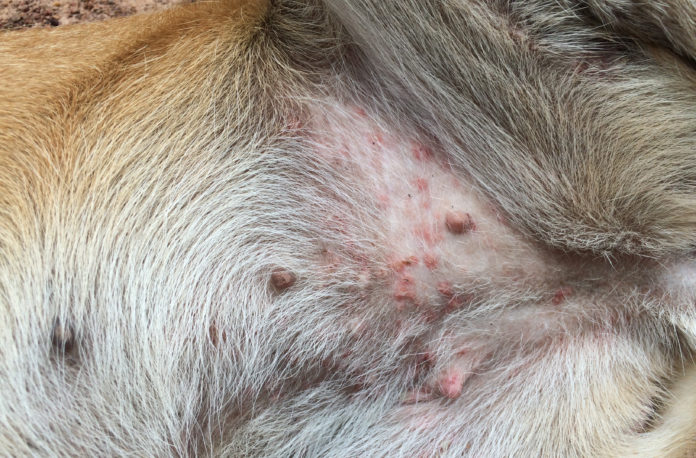What’s causing your dog’s belly rash?

Is your dog scratching or biting at her stomach? Is it red and bumpy? Here’s what might be causing this uncomfortable belly rash!
You’re on the couch gently scratching your dog’s belly when suddenly you realize your pooch has a rash. It looks like red bumps or acne-type lesions. Uh-oh! What caused it and how can you treat it?
Most belly rashes in dogs are caused by:
- Allergic or contact dermatitis
- Bacterial or fungal infection
- Parasites like fleas, mites or ticks
- Heat rash
Any of these may cause excessive scratching, licking, biting, or other symptoms such as pain, tenderness, sneezing, watery eyes, hair loss, diarrhea or vomiting. Let’s break down the possibilities to help you determine exactly what’s going on.
Allergic or contact dermatitis
Your dog may have eaten or inhaled something such as mold or pollen, or come into contact with poison ivy, fertilizer, road salt, hay or other irritants. If allergies are the cause, then the simplest solution is to avoid the allergen. Stay away from these irritants while walking your dog in your neighborhood or playing with her in your yard. You can also take regular preventative measures such as vacuuming frequently, changing her diet or regularly bathing her with a hypoallergenic medicated shampoo.
Bacterial or fungal infections
Sometimes the cause of a dog’s rash is a bacterial, fungal or yeast infection. These start as a result of a cut or scrape or from too much moisture or other trauma to the skin. Ringworm is a fungus infection that shows up as circular lesions that are scabby and red. Be extremely careful with ringworm – it is highly contagious and can be passed on to your other pets and you!
Impetigo is a bacterial infection that can look like small, pus-filled bumps on your dog’s belly and usually affects puppies rather than older dogs. If your puppy has a rash on her belly, it may be bacteria staphylococcus which causes patches of infection to appear in hairless sections of the stomach. It can be extremely painful and contagious. To alleviate it, apply chlorhexidine, hydrogen peroxide, benzoyl peroxide two times a day or an antiseptic and anti-fungal product such as Banixx Pet Care.
Fleas, mites and ticks
Bites from fleas, mites or ticks may be another cause of your pup’s belly rash. Flea saliva is an especially potent cause of allergic reaction in dogs – leading to everything from itchy red bumps to hot spots and hair loss. Controlling those pesky fleas is your number one priority if you want to prevent discomfort. If your dog is left untreated for fleas, they will take up residence in your home and eventually bite you too! A wide variety of flea shampoos and topical or systemic treatments are available from your veterinarian. If the bites are caused by mites, you may be looking at a case of mange, which can cause a rash on your dog’s skin, including the tummy and groin. Your veterinarian will need to prescribe an anti-parasitic medication to kill the mites. Mites may be contagious so act quickly to determine what type of mite is involved. In all cases, don’t forget to wash your dog’s bedding with a mild bleach solution and clear water rinse.
Heat rash
Just like with impetigo, heat rash is caused by the staphylococcus bacteria and flares up in hot, humid weather. It looks like red spots on your dog’s tummy. It may appear on the back, folds of skin, under the tail, neck and near her ears. Heat rash starts off as a skin irritation that causes your dog to scratch a lot, and may progress to boils, pimples, scabs and a nasty smell. Cool your dog off by applying cold compresses or ice packs to the area for about 10 minutes several times a day until the condition improves.
No matter what’s causing your dog’s irritating red belly rash, take immediate steps to treat it by consulting with your veterinarian and using safe and effective products that help to quickly relieve and resolve the rash and help your pooch (and you) feel better.





